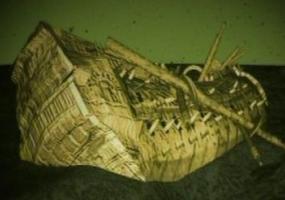 Civilian divers were on an archeological dive on the London, a Royal Navy ship built-in 1656 which exploded and sank in 1665 in the Thames Estuary. They were shocked to find a large World War II bomb in the wreck. And it wasn’t just any bomb. The BBC reports that it was a German parachute ground mine, at 987kg (2,175lbs) one of the biggest bombs used by the Luftwaffe during the war.
Civilian divers were on an archeological dive on the London, a Royal Navy ship built-in 1656 which exploded and sank in 1665 in the Thames Estuary. They were shocked to find a large World War II bomb in the wreck. And it wasn’t just any bomb. The BBC reports that it was a German parachute ground mine, at 987kg (2,175lbs) one of the biggest bombs used by the Luftwaffe during the war.
A team of eight Royal Navy bomb disposal experts worked for six days in poor visibility to retrieve the bomb, which was then detonated five miles away, at a disposal site at Shoeburyness, off the Essex coast.
In 1665, the powder magazine on the London, a 76-gun second-rate ship of the line, spontaneously exploded, killing 300 of her crew and sending the ship to the bottom. The wreck was rediscovered in 2005, causing authorities to change the route of the nearby shipping channel to prevent further damage to the wreck. In 2015, an intact gun carriage was lifted from the seabed near the wreck site.
Exactly how the World War II bomb came to rest in the 17th-century wreck is unclear.

“Well, heck, Frank, we found wot sunk her.”
“I dunno, Mort, they have para bombs in the 17th century?”
“Looks like, Frank, looks like.”
“Exactly how the World War II bomb came to rest in the 17th-century wreck is unclear.”
You are joking? Right?
I meant to suggest that it is an interesting coincidence that a ship that spontaneously exploded in 1665 happened to become the resting place of a large bomb 280 years later given the expanse of the Thames Estuary.
A very good friend of mine, Peter Wilson, has bought and restored a Silvers Motor Yacht with quite a history.
In WWII she was requisitioned by the Royal Navy to monitor German bombers dropping mines into the lower Clyde shipping channel. One night she observed a mine landing near Langbank and moved in to drop a Dhan Buoy to mark it for the RN bomb disposal squad to deal with.
Unfortunately, as they departed the area the mine detonated and she was blown 12 feet out of the water. When she landed her caulking was blown and she was taking on water. The crew ran her up into shallow water and, shell shocked, the crew abandoned ship and waded ashore, up a beach, over a bund (levy) where they found a farm. The Farmer and his wife plied them with succour and relief, (whisky), and one of the crew required to “powder his nose” and went to the outside toilet which was a small dunny (shed) on top of the bund. At this point a German bomber dropped another mine which exploded close-by and blew the dunny from around him exposing him to the world.
He remains the only man to have been mined twice in a few hours.